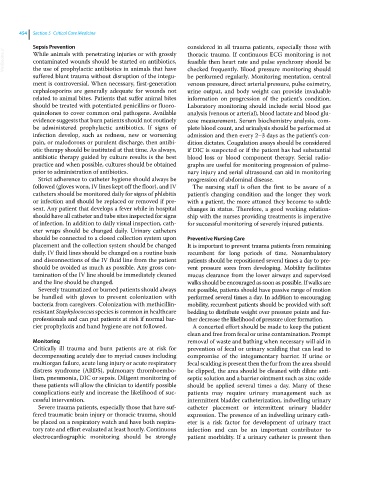Page 486 - Clinical Small Animal Internal Medicine
P. 486
454 Section 5 Critical Care Medicine
Sepsis Prevention considered in all trauma patients, especially those with
VetBooks.ir contaminated wounds should be started on antibiotics, thoracic trauma. If continuous ECG monitoring is not
While animals with penetrating injuries or with grossly
feasible then heart rate and pulse synchrony should be
the use of prophylactic antibiotics in animals that have
be performed regularly. Monitoring mentation, central
suffered blunt trauma without disruption of the integu- checked frequently. Blood pressure monitoring should
ment is controversial. When necessary, first‐generation venous pressure, direct arterial pressure, pulse oximetry,
cephalosporins are generally adequate for wounds not urine output, and body weight can provide invaluable
related to animal bites. Patients that suffer animal bites information on progression of the patient’s condition.
should be treated with potentiated penicillins or fluoro- Laboratory monitoring should include serial blood gas
quinolones to cover common oral pathogens. Available analysis (venous or arterial), blood lactate and blood glu-
evidence suggests that burn patients should not routinely cose measurement. Serum biochemistry analysis, com-
be administered prophylactic antibiotics. If signs of plete blood count, and urinalysis should be performed at
infection develop, such as redness, new or worsening admission and then every 2–3 days as the patient’s con-
pain, or malodorous or purulent discharge, then antibi- dition dictates. Coagulation assays should be considered
otic therapy should be instituted at that time. As always, if DIC is suspected or if the patient has had substantial
antibiotic therapy guided by culture results is the best blood loss or blood component therapy. Serial radio-
practice and when possible, cultures should be obtained graphs are useful for monitoring progression of pulmo-
prior to administration of antibiotics. nary injury and serial ultrasound can aid in monitoring
Strict adherence to catheter hygiene should always be progression of abdominal disease.
followed (gloves worn, IV lines kept off the floor), and IV The nursing staff is often the first to be aware of a
catheters should be monitored daily for signs of phlebitis patient’s changing condition and the longer they work
or infection and should be replaced or removed if pre- with a patient, the more attuned they become to subtle
sent. Any patient that develops a fever while in hospital changes in status. Therefore, a good working relation-
should have all catheter and tube sites inspected for signs ship with the nurses providing treatments is imperative
of infection. In addition to daily visual inspection, cath- for successful monitoring of severely injured patients.
eter wraps should be changed daily. Urinary catheters
should be connected to a closed collection system upon Preventive Nursing Care
placement and the collection system should be changed It is important to prevent trauma patients from remaining
daily. IV fluid lines should be changed on a routine basis recumbent for long periods of time. Nonambulatory
and disconnections of the IV fluid line from the patient patients should be repositioned several times a day to pre-
should be avoided as much as possible. Any gross con- vent pressure sores from developing. Mobility facilitates
tamination of the IV line should be immediately cleaned mucus clearance from the lower airways and supervised
and the line should be changed. walks should be encouraged as soon as possible. If walks are
Severely traumatized or burned patients should always not possible, patients should have passive range of motion
be handled with gloves to prevent colonization with performed several times a day. In addition to encouraging
bacteria from caregivers. Colonization with methicillin‐ mobility, recumbent patients should be provided with soft
resistant Staphylococcus species is common in healthcare bedding to distribute weight over pressure points and fur-
professionals and can put patients at risk if normal bar- ther decrease the likelihood of pressure ulcer formation.
rier prophylaxis and hand hygiene are not followed. A concerted effort should be made to keep the patient
clean and free from fecal or urine contamination. Prompt
Monitoring removal of waste and bathing when necessary will aid in
Critically ill trauma and burn patients are at risk for prevention of fecal or urinary scalding that can lead to
decompensating acutely due to myriad causes including compromise of the integumentary barrier. If urine or
multiorgan failure, acute lung injury or acute respiratory fecal scalding is present then the fur from the area should
distress syndrome (ARDS), pulmonary thromboembo- be clipped, the area should be cleaned with dilute anti-
lism, pneumonia, DIC or sepsis. Diligent monitoring of septic solution and a barrier ointment such as zinc oxide
these patients will allow the clinician to identify possible should be applied several times a day. Many of these
complications early and increase the likelihood of suc- patients may require urinary management such as
cessful intervention. intermittent bladder catheterization, indwelling urinary
Severe trauma patients, especially those that have suf- catheter placement or intermittent urinary bladder
fered traumatic brain injury or thoracic trauma, should expression. The presence of an indwelling urinary cath-
be placed on a respiratory watch and have both respira- eter is a risk factor for development of urinary tract
tory rate and effort evaluated at least hourly. Continuous infection and can be an important contributor to
electrocardiographic monitoring should be strongly patient morbidity. If a urinary catheter is present then

